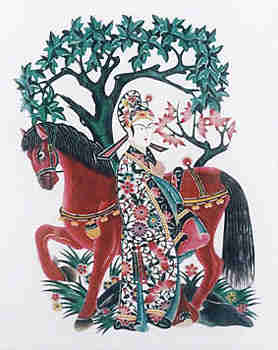 In the 13th century, the shadow shows became regular recreation in the barracks of Mongolian troops. They were spread by the conquering Mongols to distant lands like Persia, Arabia and Turkey. Later, the art was introduced to Southeastern Asian countries, too.
In the 13th century, the shadow shows became regular recreation in the barracks of Mongolian troops. They were spread by the conquering Mongols to distant lands like Persia, Arabia and Turkey. Later, the art was introduced to Southeastern Asian countries, too.
Shadow puppets began to spread to Europe in the mid-18th century, when French missionaries to China took them back to France in 1767 and put on performances in Paris and Marseilles, causing quite a stir. In time, the so-called ombres chinoises, with local modifications and embellishments, became the ombres Francaises and took root in the country.
As present, more than 20 countries are known to have shadow show troupes.
A puppet figure requires five bamboo-sticks to operate. So the performer is usually highly sought-after, since he or she must not only have the ability to operate a puppet and sing and talk, but also be able to play a percussion instrument by foot.
 Longdong Shadow Plays
Longdong Shadow Plays
Shadow plays are a folk art, and the Longdong shadow plays originated in rural areas of northwest China's Gansu, Shannxi and Ningxia provinces.
Such art was popular between 14th and 19th Century, which is the Ming and Qing Dynasty in China. Figures used in the play look pretty and charming and carving technique requires great skills.
The material used for Longdong shadow plays is ox skin, which is durable and soft with just the right thickness. People first clean and dry the skin, after drawing and carving the material. Then, then they put it in water to add color and take it out to iron it, which is the most difficult yet important step. Lastly, the skin is dried and bound together before it can be used in performances.
